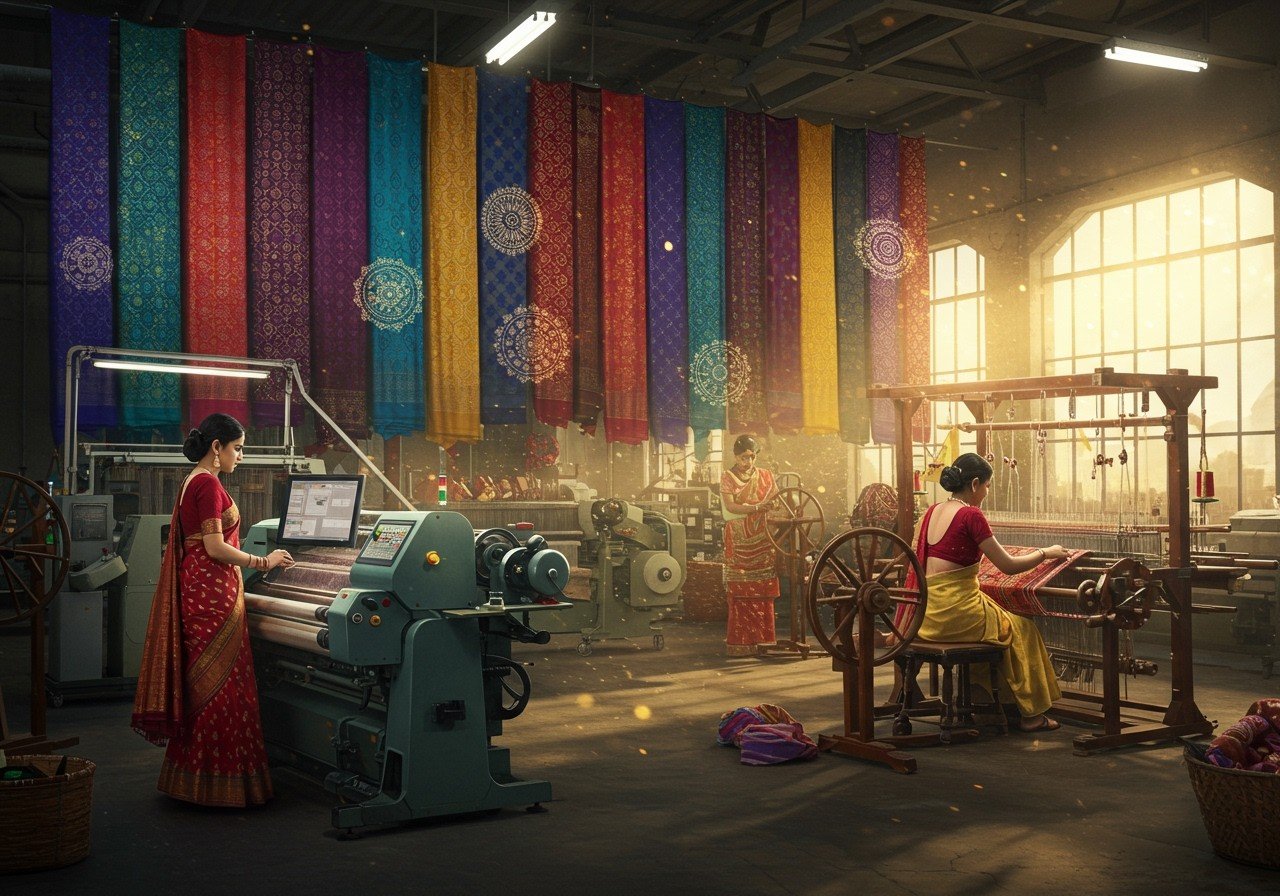
India’s textile industry boasts a rich heritage, evolving from ancient handloom traditions to its current global prominence. This sector is a cornerstone of India’s economy, generating employment and driving export revenue. Textiles are deeply intertwined with Indian culture, playing a significant role in rituals and everyday life. The industry’s diverse structure, encompassing handloom, power loom, and mill sectors, sets the stage for exploring its growth, development, challenges, and opportunities.
The Rise of India’s Textile Industry (2014-2024)
Over the past decade, India’s textile industry has experienced remarkable growth. This expansion is fueled by both domestic demand and international exports. Investments in infrastructure and the adoption of new technologies have propelled the industry forward. Government initiatives, such as “Make in India” and the establishment of Textile Parks, have provided crucial support. Robust export markets in the US and EU have contributed significantly to revenue generation. The emergence of e-commerce has opened up new avenues for growth, while India’s expanding middle class has fueled demand for a diverse range of textile products.
Technological advancements have played a transformative role in the industry’s growth. Automation, AI, and data analytics are revolutionizing textile manufacturing, leading to enhanced efficiency, productivity, and quality. Notably, the rise of Digital Textile Printing (DTP) allows for direct printing on fabric, reducing waste and costs. This focus on technology has enabled poojn.in to offer high-quality printed clothes like our XL Size Mayapuri Bhagwa Namavali.
Government support, through initiatives like “Make in India,” has attracted both domestic and foreign investments. Textile Parks provide essential infrastructure and resources for industry expansion. By 2025, exports are projected to reach $300 billion, attracting investments worth $120 billion, signifying a remarkable growth trajectory. This growth is facilitated by premium quality original cotton white markin cloth and other quality products.
E-commerce has emerged as a significant growth driver, providing consumers with easy access to a wide array of textile products. This shift aligns with India’s broader digital transformation. Sustainability is another key factor, with increasing demand for clothing made from natural fibers such as cotton, silk, linen, and wool. Eco-friendly practices are becoming increasingly prevalent in production processes. This growing demand for sustainability is reflected in the increasing popularity of premium quality original cotton red shalu cloth for rituals and ceremonies.
Technical textiles, known for their enhanced durability and specialized applications in healthcare and automotive sectors, are gaining traction. Furthermore, smart textiles, which respond to external stimuli, hold immense potential in medical, sports, and fashion industries. Find authentic and high-quality products such as paddy seeds for puja, chand mala, camphor powder, cotton threads, and black sesame on poojn.in to support the growth of India’s textile industry.
Poojn.in’s Role in Supporting the Indian Textile Industry
Poojn.in actively contributes to the growth of India’s textile industry by offering a curated selection of pure cotton products specifically for religious and cultural purposes. We provide authentic corpus cotton items that adhere to traditional quality standards while supporting local artisans and manufacturers. Explore our blog posts on Chhinnamasta Devi, Rajrappa, and Maluti Temples to delve deeper into Indian culture and heritage.
Key benefits of choosing Poojn.in for your textile needs:
- Direct access to pure corpus cotton items: We maintain stringent quality control to ensure authenticity and adherence to traditional standards.
- Support for local artisans and manufacturers: Your purchase directly contributes to the livelihoods of local communities and preserves traditional craftsmanship.
- Quality-checked products for religious and cultural use: Our products are carefully inspected to meet specific religious and cultural requirements.
- Convenient online shopping and pan-India delivery: Enjoy a seamless online shopping experience with reliable delivery across India.
- Transparent product information and authenticity verification: We provide detailed product information and ensure the authenticity of our offerings.
The Future of India’s Textile Industry
The Indian textile industry is poised for continued growth, projected to reach a market value of $350 billion by 2025, with a CAGR of 14.8% from 2021. By 2029, the market is anticipated to exceed $209 billion. This growth is driven by several key factors:
- Increasing demand for natural fibers: Consumers are increasingly seeking sustainable options, driving demand for natural fibers like cotton, silk, and linen. This shift aligns with a global focus on environmentally friendly products.
- Growing middle class: India’s expanding middle class fuels demand for clothing, home textiles, and various other textile products, creating a robust domestic market.
- Government support: Initiatives like “Make in India” and supportive policies attract domestic and foreign investments, fostering industry growth.
- Technological advancements: Automation, AI, and data analytics are transforming textile manufacturing, increasing efficiency and quality.
- Rise of digital textile printing: DTP reduces waste and costs, offering design flexibility and customization options. This technology allows for intricate patterns and personalized designs, catering to diverse consumer preferences.
- Focus on technical textiles: Demand for specialized textiles in sectors like healthcare and automotive is on the rise, driving innovation and growth in this segment.
- Sustainability: Eco-friendly practices and waste recycling are gaining importance, as companies prioritize sustainability in their value chains.
- Growing need for yarn quality: Meeting the demands of both domestic and international markets requires a focus on producing high-quality yarn.
Key trends shaping the future of the industry include a growing emphasis on sustainability, the development of smart textiles, and the adoption of digital and 3D printing technologies. The use of non-woven fabrics is also expanding across various sectors. Learn more about these trends and other cultural insights in our blog posts on South India’s Sacred Sites, Prasad Recipes, and Sanskrit Mantras.
Challenges and Opportunities: Navigating the Future
While the Indian textile industry enjoys significant growth potential, it also faces challenges such as global competition, fluctuating raw material prices, and the need for continuous modernization and sustainable practices. However, these challenges also present opportunities for innovation and growth.
What fuels the growth of India’s textile sector? Several factors contribute, including abundant raw materials like cotton, supportive government policies fostering growth and innovation, and a large, expanding domestic market eager for textile goods.
How has technology impacted the sector in the last decade? The last ten years have witnessed modernization through technology, a surge in textile exports, and significant investment in infrastructure, all contributing to impressive growth. Articles such as “Hatimura Durga Temple” and “Maha Shivaratri 2025” provide further context on the cultural significance of textiles.
What is the role of cotton in India’s growth? The cotton textile industry serves as a significant economic driver, creating jobs for millions and contributing substantially to export earnings. As a cornerstone of the sector, it spans a vast chain from cotton farming to garment production.
What hurdles does the industry face? Key challenges include competing with other nations, volatile raw material costs, and the crucial need for modernization and sustainable manufacturing processes. Find resources and insights in “Hindu Temple Architecture” and “Key Elements of Traditional Hindu Architecture.”
By embracing sustainable practices, investing in technological advancements, and focusing on emerging trends like smart textiles, India’s textile industry can navigate these challenges and unlock its vast potential. Explore our blog posts on “Hindu Architecture Styles” and “Hindu Architecture: Tradition Meets Modern Design” for more insights.


